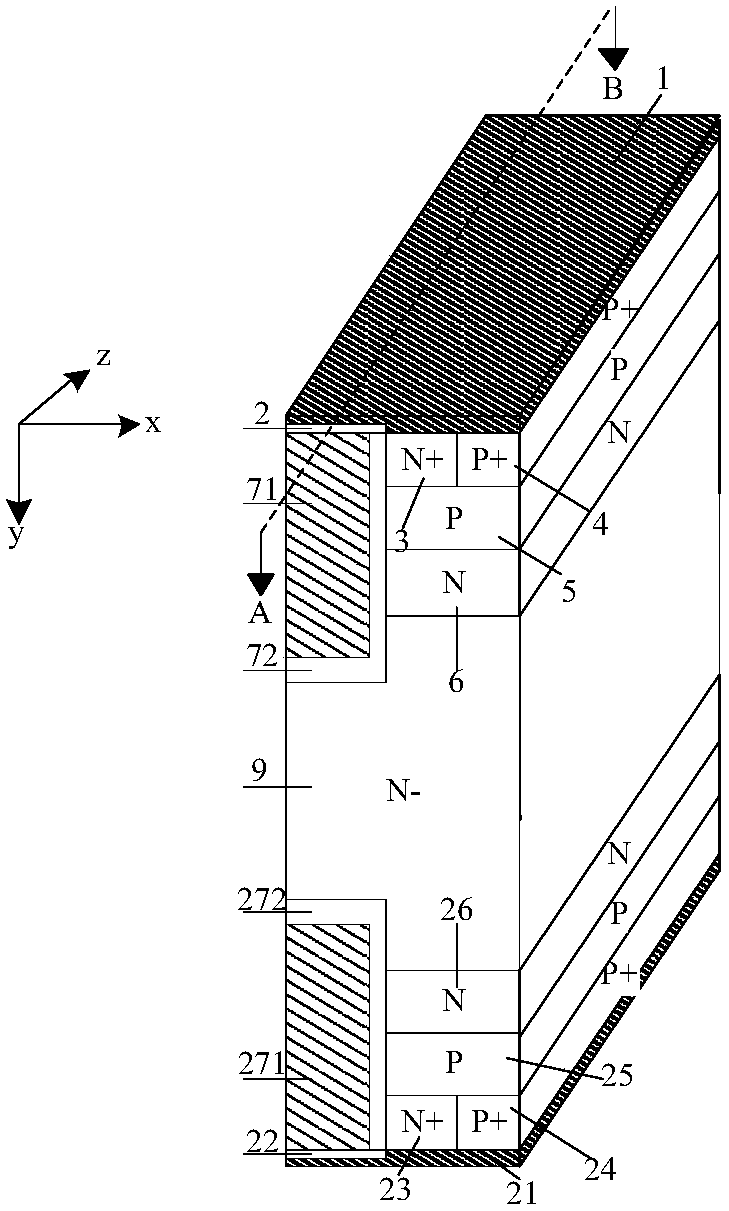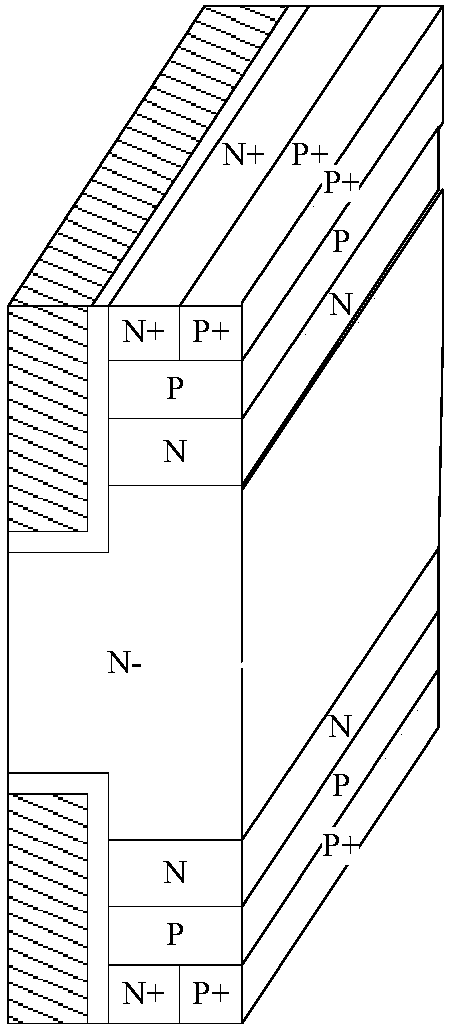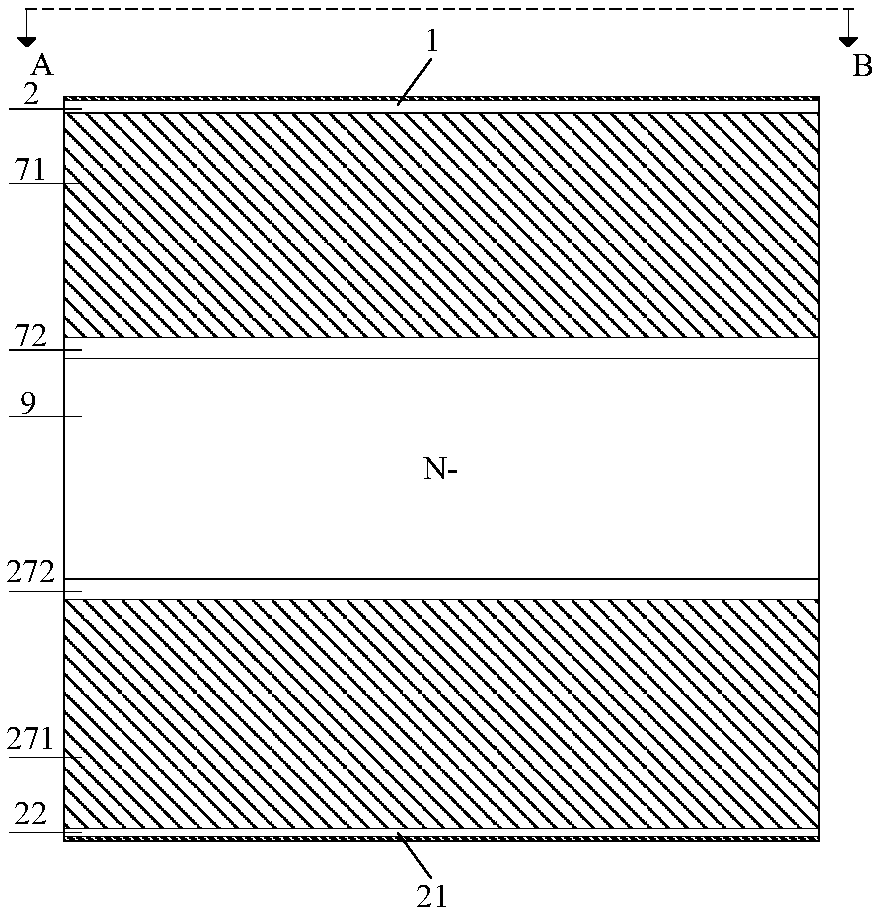Bidirectional trench gate charge storage type IGBT (Insulated Gate Bipolar Translator) and manufacturing method thereof
A charge storage and charge storage layer technology, applied in circuits, electrical components, semiconductor/solid-state device manufacturing, etc., can solve problems such as reduced switching speed, increased charge/discharge time, and poor device reliability
- Summary
- Abstract
- Description
- Claims
- Application Information
AI Technical Summary
Problems solved by technology
Method used
Image
Examples
Embodiment 1
[0084] A bidirectional trench gate charge storage type IGBT, one half of its cells are as Figure 4 As shown, its section along AB line and CD line is as follows Figure 6 and Figure 7 As shown, a three-dimensional coordinate system is established with any inflection point of one-half cell as the origin, and the bottom surface of one-quarter cell intersects with the two sides of the inflection point as the x-axis and z-axis respectively, passing through the inflection point and A straight line perpendicular to the bottom surface is used as the y-axis, and the directions of the x, y, and z-axes refer to Figure 4 ;
[0085] The half cell includes MOS structures respectively arranged on the front and back of the N-type drift region 9; it is characterized in that: the front MOS structure includes a front emitter metal 1, a front isolation dielectric layer 2, and a front split trench gate structure , the front first conductivity type semiconductor emitter region 3, the front sid...
Embodiment 2
[0089] A bidirectional trench gate charge storage type IGBT, one half of its cells are as Figure 8 As shown, its section along AB line, CD line, EF line and GH line is as follows Figures 10 to 13 As shown, the establishment method of the coordinate system is as in the embodiment, see for details Figure 8 ;
[0090] The difference between this embodiment and Embodiment 1 is that the extension depth of the front gate electrode 71 in the top layer of the N-type drift region 9 in this embodiment is equal to the extension depth of the front split electrode 81, and the extension width of the front gate electrode 71 in the top layer of the device It is less than the extension width of the front split electrode 81, and at the same time, a part of the front split electrode dielectric layer 82 and a part of the front split electrode 81 structure are retained on the top layer of the device; the thickness of the front split electrode dielectric layer 82 is greater than the thickness o...
Embodiment 3
[0093] A bidirectional trench gate charge storage type IGBT, one half of its cells are as Figure 14 As shown, its section along AB line, CD line, EF line and GH line is as follows Figures 16 to 19 As shown, the establishment method of the coordinate system is as in the embodiment, see for details Figure 14 ;
[0094] The difference between this embodiment and Embodiment 2 is that in this embodiment, the front split electrode 81 and the split electrode dielectric layer 82 are not provided on the top layer of the device front MOS structure, and the front split electrode 81 and the front split electrode dielectric layer 82 are located on the front gate electrode. 71 bottom, the front N+ emitter region 3 and the front P+ body contact region 4 have the same depth along the z-axis direction and are less than the depth of the front P-type base region 5 along the z-axis direction, and at the same time pass the front gate dielectric layer 72 with the front N+ emitter region 3 The ...
PUM
| Property | Measurement | Unit |
|---|---|---|
| Thickness | aaaaa | aaaaa |
| Thickness | aaaaa | aaaaa |
Abstract
Description
Claims
Application Information
 Login to View More
Login to View More - R&D
- Intellectual Property
- Life Sciences
- Materials
- Tech Scout
- Unparalleled Data Quality
- Higher Quality Content
- 60% Fewer Hallucinations
Browse by: Latest US Patents, China's latest patents, Technical Efficacy Thesaurus, Application Domain, Technology Topic, Popular Technical Reports.
© 2025 PatSnap. All rights reserved.Legal|Privacy policy|Modern Slavery Act Transparency Statement|Sitemap|About US| Contact US: help@patsnap.com



